Menu
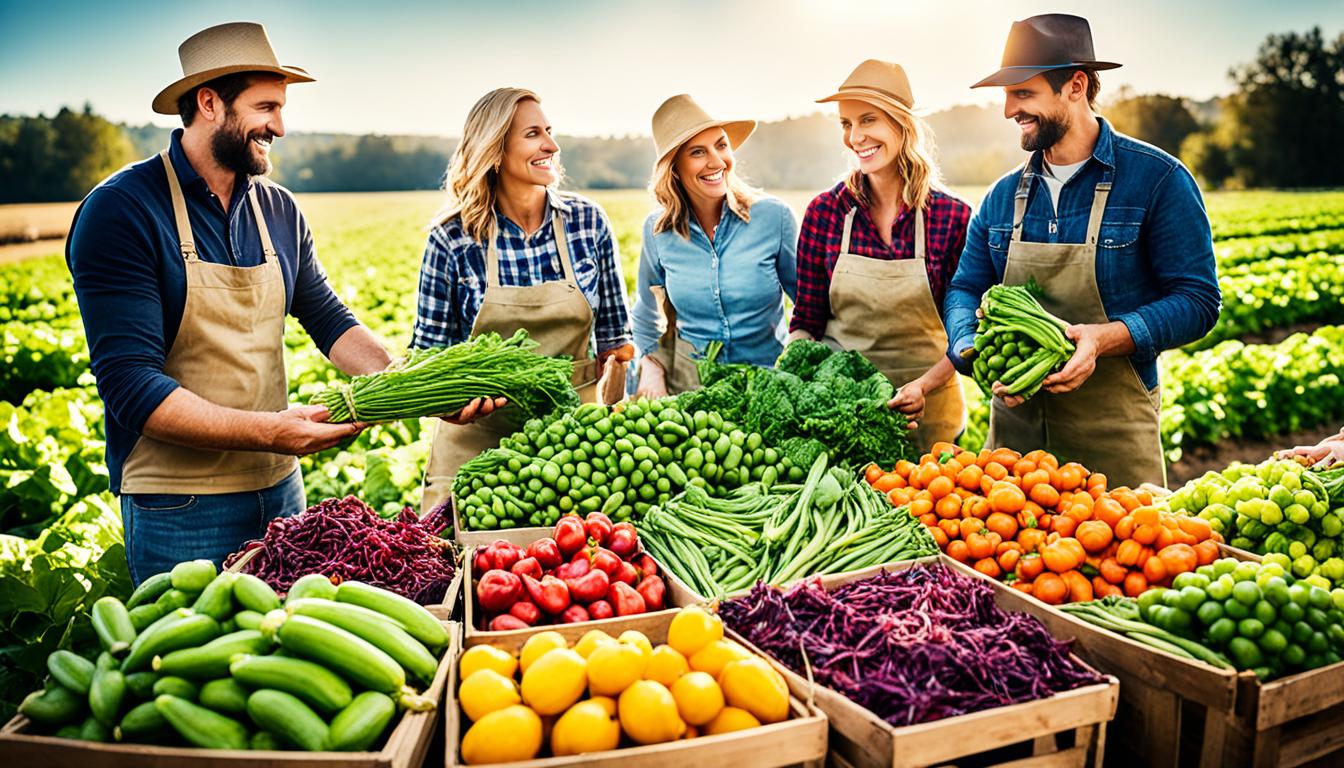
Did you know, CSA customers pay around $300 to $600 a year for a box of fresh produce? However, many farms find it hard to keep these customers loyal. This shows why marketing for small farms is crucial. They aim to bring local, high-quality goods to people but often lack the resources.
Collaborative marketing helps these farms shine. By working together with other farms and local stores, they reach more people. This strategy not only boosts sales but also creates stronger customer bonds.
Farms that work closely with cities can benefit too. They can use clever marketing to connect with the community. This could involve joint events, combined offerings, and telling their stories together.
Collaborative marketing is key for small farms fighting operation issues. Their focus is on doing better, not just on ads. The Cornell Cooperative Extension of Broome County stands out for its work in this area. They found that small farms don’t have many resources for marketing together, unlike big cooperatives.
They have got farms and Extension educators more involved through talks and workshops. They’ve also helped create new ways to pool resources, like tools for joining community-supported agriculture. These steps are all about making marketing together work even better.
Four farms shared how they’re using these new tools. Through the project, they set up agreements and budget plans. They also got to talk with experts on how to work better together. They didn’t have much help before, but now they’ve learned a lot about smarter marketing.
Direct Farm Manitoba also adds to the conversation, sharing tips in online talks. For example, Justin Girard and Britt Embry work with a beef farm. They help each other with sales. They sell everything from fresh veg to meat and even do fundraising events together. These stories show how sharing and working together can help small farms grow.
John Muller shares his own success story from a chicken farm. With ideas from his previous farm jobs, he started working with other farmers on ads. Even small changes, he says, can make a big difference in how people see you and your products.
Community Supported Agriculture (CSA) schemes boost financial stability in farming. They bring farmers and local consumers together. This arrangement ensures the farm’s survival while offering fresh, local produce to those who subscribe.

CSAs help farmers by lessening the impact of unpredictable market changes. Members pre-buy “shares” that are usually $400 to $700 a year. This provides farmers with upfront cash.
It means they can plan better, knowing they have already sold part of their harvest. For example, North Carolina CSAs sell shares at around $400 to $700 each. Membership is flexible with payment plans to help low-income families join. People can also work on the farm to pay off their share. This system has helped CSAs maintain a good number of members over the years. Activities like on-farm events and education keep members connected and interested.
In CSA models, both farmers and consumers share the risks. When customers buy shares ahead, they also take on a bit of the farming risk. In return, they get fresh, seasonal produce.
Maryland, for example, offers a variety of CSAs, including those for different seasons. They provide fruits, vegetables, eggs, meat, dairy, and even treats like coffee and jams. This mix makes CSAs appealing and budget-friendly for consumers.
The number of CSAs in the United States has grown a lot since 1990. It went from 50 to over 2,500. This shows how successful and important CSAs have become in supporting local farming.
| State | Number of CSAs | Cost Range (Full Share) | Varieties Offered |
|---|---|---|---|
| North Carolina | 100+ | $400 – $700 | Full, Half, Work-Share |
| Maryland | Numerous | $300 – $900 | Traditional, Summer, Fall, Winter, Year-Round |
“`
CSAs are more than just farms and consumers working together. They create a sustainable environment where everyone benefits. Their success and variety of produce show how important they are for our food system.
Creating strong local business partnerships is key for small farms to grow and become well-known. The need for local food is rising not just in Georgia, but everywhere. By connecting with local businesses, small farms can find great marketing and growth chances. These links usually start at farmer’s markets, where both farmers and buyers meet. This helps to build trust and loyalty.
Farmers need to spend time making new connections and keeping the old ones. To do this, they should think about working together with neighbouring farms and businesses. This teamwork can bring about shared promotions, combined product deals, and more notice from people in the area.
Working with restaurants and chefs on using local produce can benefit everyone. While it takes time to make these links, the results are worth it. Getting regular orders from these places can help to steady a farm’s income. This allows farmers to plan better for the future.
It’s also a good idea for farmers to work with schools, through programs like Farm to School. By directly supplying schools, kids get to eat fresh, healthy food. This supports local farming and meets strict food safety rules for the young.
Here’s a quick overview of how local business bonds can help small farms:
| Channel | Benefits |
|---|---|
| Farmer’s Markets | Direct consumer engagement, fostering trust and loyalty |
| Restaurants and Chefs | Consistent sales, stable income stream |
| Schools (Farm to School Programs) | Guaranteed market, adherence to food safety standards |
| Mutual Promotion Schemes | Increased visibility, collaborative marketing campaigns |
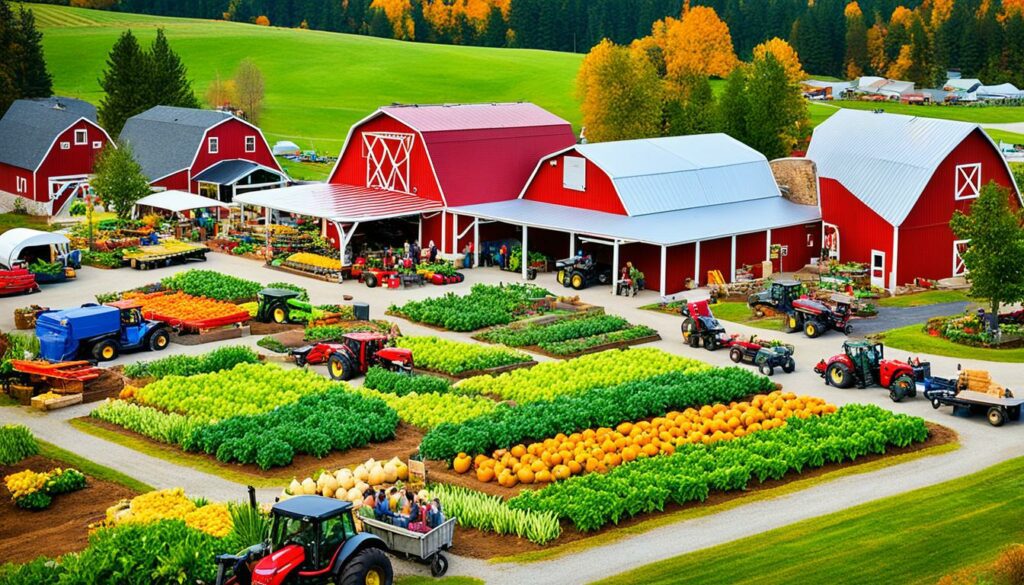
Agritourism is key for farmers wanting new revenue sources and closer community links. The number of farm visitors and income growth show its potential. Between 2007 and 2012, farms profiting from agritourism increased from 10,249 to 13,334. This jump in activity highlights its economic advantages and growing interest in visiting farms.
There’s a wide range of agritourism activities people can enjoy and learn from:
From 2001 to 2009, farm visits rose by 28%, attracting over 75 million people. This shows a big, growing interest in learning about farms and having fun.
Agritourism isn’t just about money; it builds strong ties between city and country life. This community involvement helps create lasting bonds:
Yet, agritourism faces challenges like zoning laws. Working together through agritourism coalitions can make it easier to tackle these issues.
Places like Breedbooks aim to help over 149,000 small U.S. farms by providing tools for better online marketing, sales, and managing tours, changing small farming through agritourism.
| Status | Number of Farms | Total Revenue ($) | Percentage of Total |
|---|---|---|---|
| 2007 Census | 10,249 | 546 million | – |
| 2012 Census | 13,334 | 674 million | – |
| Growth | +3,085 | +128 million | – |
Working together helps small farmers make their brand more known in farming. It’s tough when people can’t always see you well. Strong, easily recognisable brand names are key. But time, not enough products, and different quality can get in the way of shared marketing. It’s important to think hard about joint branding to see if it fits what you do.
Informal deals are often better than written contracts in many areas. Joint branding boosts how much customers know and like you by using everyone’s market power. For example, beekeepers work together to sell more honey in local and big markets.
There aren’t many guides out there for marketing together, unlike for cooperatives. But a clear template for Marketing Agreements can help. It tells you what to do, how to check if it’s working, and how to use each other’s logos wisely. By working together, small farmers can save money on marketing and reach more people.
Cooperatives are groups where users run the show and share the wins. They help find new places to sell and spend less on getting the word out. Different levels of government have programs that help these groups with money and advice.
Online, around 3 billion people use Facebook. This huge number could be great for spreading the word about farms or farm visits. People love sharing unique, fun stories online. This makes joint marketing even more important for small farms.
Starting good agricultural co-marketing strategies is all about telling stories. These stories should show what’s special about your farm. They help customers connect more with your brand. When we tell these stories in our marketing, people value our products more.
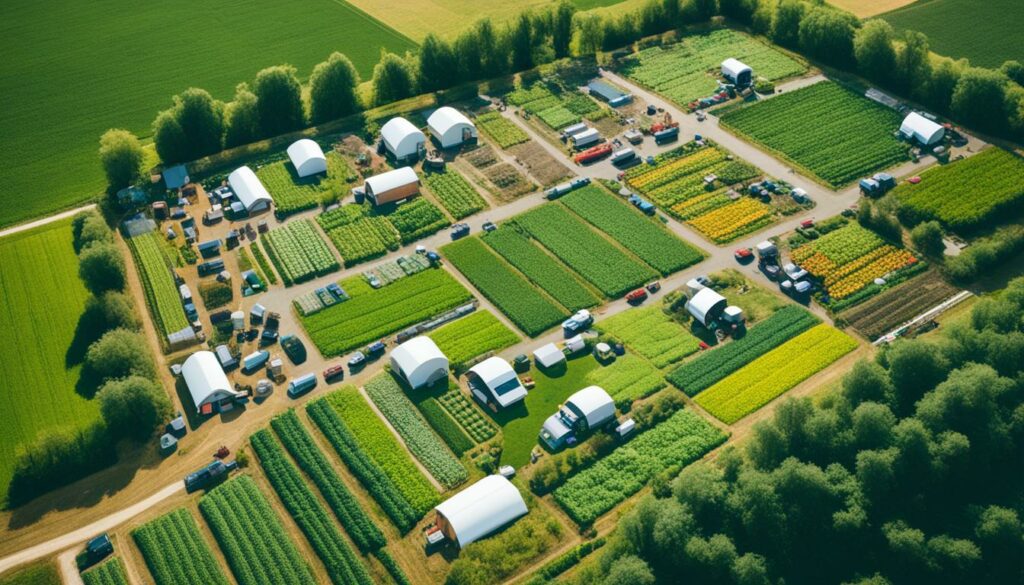
Using direct marketing is key here. Take, for example, selling at local events. This not only lets you show off your goods. It also lets you talk to people face-to-face. This way, more people get to know and love your products.
Collaborative marketing is great for small and medium farms. By working together, these farms can do more. For example, they can offer a wider range of products, like a winter CSA, which one farm couldn’t do alone.
There are many ways to team up, like partnerships or LLCs. Food hubs are also an option. They help small producers reach more buyers. This means they can sell more and grow their business.
Places like farm incubators help new and old farmers. They offer help and fair deals on land. This makes starting or growing a farm with others less risky and more attractive than doing it alone.
“The cooperative nature of food hubs and marketing co-ops not only aggregates and distributes products effectively but also empowers farmers through shared branding and collective marketing efforts.”
To wrap up, working together and having a strong brand are key. Through these methods, we make our farm a bigger player in the market. This helps us all stay in business for the long run.
Cooperative advertising boosts the influence of marketing for rural producers and farms. By working together, they can stand out more in the market. This approach allows small farms to pull their resources. This way, they have a bigger impact with their ads.
Cooperative advertising cuts the cost of marketing for rural producers. It’s a team effort that spreads the expenses. Everyone benefits from a bigger presence in ads. This kind of approach is vital today as most customers start looking for products online. A strong presence on Facebook, with its large audience, can make a big difference. Businesses on Facebook get a lot more interaction than on other platforms, showing its worth.
Cooperative campaigns in farming have led to great success. Some farm cases stand out. For example, when farms work together in agritourism, they not only get more visibility. They also create experiences people enjoy and share. Using each other’s customer basis, these efforts become more effective. Unique strategies, like selling together in online auctions, have also seen great outcomes. These all show how uniting in advertising can really change the game.
Local growers help each other through mutual promotion. They do this by joining forces. They share their resources, skills, and what they know. This way, they can offer more things together and plan events that help them all.
Local farmers often work together in their area. They talk and learn from each other about selling and growing food. This team effort makes their business stronger. It also saves them money on advertising and getting their products ready to sell.
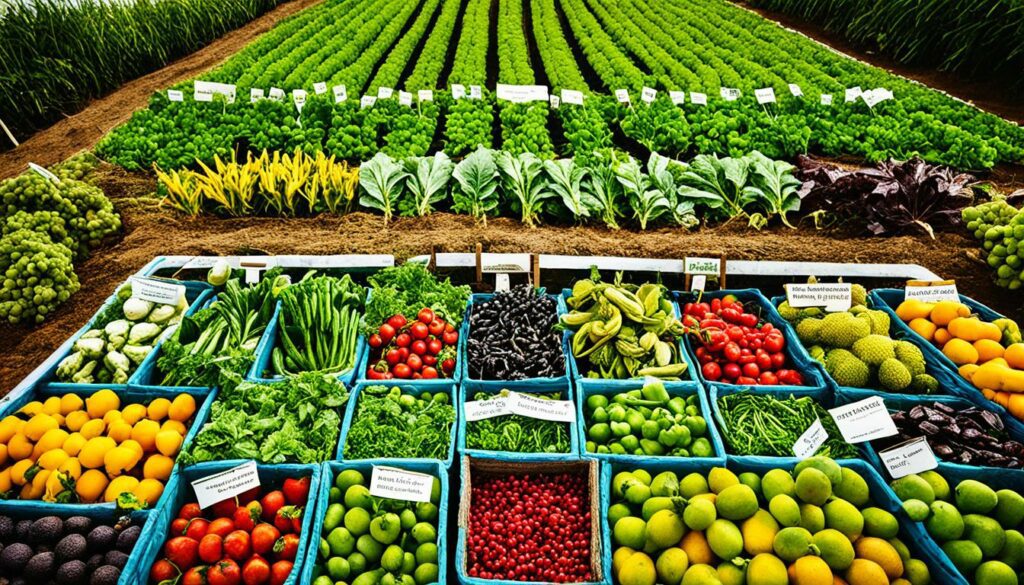
| Pros of Collaborative Farming | Cons of Collaborative Farming |
|---|---|
| Resource sharing for mutual benefit | Potential for disputes among collaborators |
| Access to shared infrastructure and distribution facilities | Challenges of personality conflicts and unequal contributions |
| Shared customer base and cost savings in marketing | Lack of control over the farm business |
Being friends with neighbouring farmers always helps, though. It can be a bit tricky sometimes. But, it usually works out. And there’s something called ‘incubator farms’. They help new farmers get what they need to start. Things like land, tools, advice, and how-to’s, making it easier for them.
The US Department of Agriculture has been a big help. They give a lot of money for projects that help local farmers team up. These projects don’t just mean better ways to sell. They keep local farms going strong, making sure people keep working together for a long time.
In today’s farming world, working together digitally is changing how small farms and groups work. AgUnity’s tech tools show a great way. They help farmers connect better, meeting rules like the EU Deforestation Regulation.
Going digital in farming makes everything clearer and faster. It also helps farmers, groups, buyers, and consumers. AgUnity teaches farmers to make smart choices, even with the modern, complex farming world.
Using social media can boost a farm’s connection with customers. Small farms can tell their story online, reaching out to people. This builds trust and turns watchers into loyal buyers. Adding AgUnity’s tech boosts trust and clear info in the farming market.
Emails are a great way for farms to reach more people. Using AgUnity’s info, farms can send emails that matter to their audience. They can talk about products, offer advice, and share events. Such emails keep the farm in people’s minds and promote eco-friendly farming.
AgUnity makes digital tools easy to use for everyone. Even those far away or not so tech-savvy can join in. These tools help small farms run better and greener.
Digital way opens up new paths for farms to connect with people. By using social media and emailing, farms can be more visible and form strong ties with customers and communities.
In Des Moines and further afield, local events offer great community events agricultural marketing chances. They let small businesses show off their goods, talk to possible customers, and make bonds. All this happens while they enjoy the perks of local teamwork.
The Downtown Farmers’ Market in Des Moines is a good example. It brings together local farmers, designers, and bakers. This boosts community ties and helps with marketing. Such markets are central to local teamwork, providing chances to network and help each other grow.
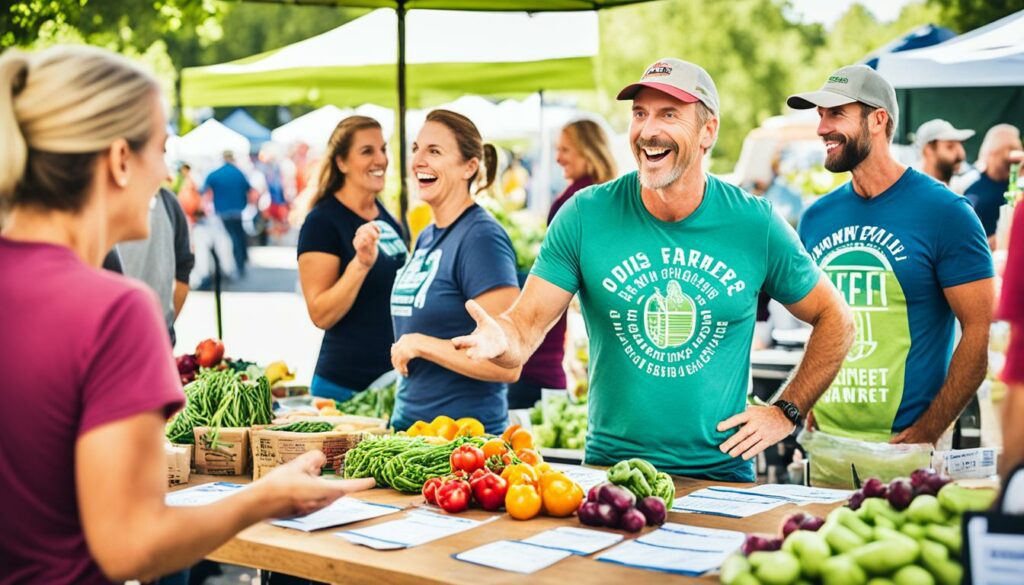
The 2nd Annual Skate DSM event by Street Plant is a prime example too. It drew in big brands like Red Bull. This made smaller businesses more visible. Partnering with known brands boosted the credibility and reach of all involved.
Also, the partnership between Principal Financial Group and the PGA TOUR Champions event in Des Moines shows how local events can lift brands globally. It’s a five-year commitment that shows the huge marketing benefits from local activities.
Events like those at Spark DSM Business Incubator and the learning opportunities at Evelyn K. Davis Center are key. They show how local collaboration opportunities help businesses that often don’t get noticed. These places help companies grow, become well-known, and pull in loyal customers and staff.
Here are some keys to successful team marketing:
Real-life stories of good partnerships are farm-to-table restaurants working with local farms and fitness studios teaming up with health cafés. These show the huge potential of community events agricultural marketing and local collaboration opportunities for growing a business and connecting with more people.
Joint ventures help small farmers beat big challenges in agriculture. Agreements like Contract Farming, Share Farming, and Business Equity Partnerships join resources. They make it easier for small farmers to enter the market and increase their income.
The high cost of land often keeps small farmers out. Joint ventures let them work together to use land better. This boosts what they can grow and sell, bringing more money in.
Contract Farming is a common example. It lasts for three to five years. It’s a deal where the farmer owns the land and the contractor brings other resources. This way, they can both earn without the farmer losing land flexibility.
Share Farming is where two businesses work together on the same land. It lets one business grow its shares slowly. This way, they can own more or all of the farm gear. It’s good for farm takeovers and buying more farms to grow.
In the SA Murray-Darling Basin, small farms have banded together with these models. Started in 2017, Natural Resources SA Murray-Darling Basin’s project helps with more farming strength. It includes sharing things like machines or creating bigger farming groups.
These agreements aren’t all about making money. Sometimes land or labour is traded for services like weed control. For example, horse agistment, where land is leased for care, shows how they help each other out.
Working together also makes it easier to sell goods and services to people. Small farms can combine products to offer better deals or do fun farm visits. This helps keep customers happy and the farming business growing strong.
| Joint Venture Type | Responsibilities | Benefits |
|---|---|---|
| Contract Farming | Farmer provides land, buildings, fixed equipment, and pays bills. Contractor provides labour, machinery, and management expertise. | Avoids formal tenancy, stable earnings for farmers, operational expertise from contractors. |
| Share Farming | Owner provides land, buildings, fixed equipment, major maintenance. Share farmer manages working machinery, moveable equipment, and pays balancing input costs. | Equity progression, potential full ownership of stock/equipment, pathway to larger farm investments. |
| Business Equity Partnerships | Shared investment in land, intellectual property, and capital. | Pool resources for large-scale operations, improved sustainability, risk sharing. |
Collaborative marketing is like a rope thrown to small farms in rough seas. It helps them navigate the difficult world of agriculture. By working together and using each other’s strengths, farms can do better in marketing. We’ll look at success stories and the key steps to start working together.
Working together can really change things for small farms. For example, teaming up with local businesses for pick-ups has boosted sales. Connecting with local Chambers of Commerce helps with networking and support. This shows how thinking outside the box can grow a farm’s business.
Sharing marketing costs and efforts makes it easier to reach more customers. This reduces spending on ads and labour. When farms work together, they can improve their and their community’s lives.
It’s smart to start small before making big commitments. This way, you can test out working together and avoid big risks. Key steps include telling a brand story that connects with people and using off-season deals to keep customers interested. Consistent goals and values are crucial for a successful partnership. Make sure any written agreements are clear and simple, so everyone understands. Include a plan to end the agreement well, if needed. This can keep things friendly and avoid legal fights.
Keep clear records by writing down all product, pricing, and payment details. This helps manage stock and avoid confusion. For more tips on working together, take a look at this detailed guide.
Choosing the right mix of teamwork and independence is the heart of partnership marketing. Whether it’s through joint sales, forming a company together, or creating a cooperative, the structure is key. Openness and a common goal make a partnership last.
Collaborative marketing lets small farms join forces. They combine resources and efforts. This boosts how many customers they reach and how well-known their brand is. It’s a way to share marketing costs and create fresh, powerful campaigns.
CSA models get consumers to buy shares of the farm’s produce ahead of time. This gives farmers upfront money. It makes the business more financially secure. With money in advance, they worry less about selling their goods and can focus on farming.
Farms can do lots of agritourism, from tours and picking days to workshops and meals. They help make extra money and get the community involved. Events like this make people more aware of the farm.
Getting to know local businesses can create chances to work together. They could make and sell items together. Or, they could share a shop or conduct marketing campaigns as a team. These links let farms find new buyers and get noticed more, helping everyone involved.
Good branding makes it easy for buyers to spot and remember a farm’s goods. Using the same look and giving extras like samples or bags makes a big difference. It helps people remember the farm and keeps them coming back.
Co-advertising often sees a few farmers working together. They might host fairs, market events, or themed festivals. By sharing ads, they reach more people and spend less. This makes their ads stronger and more fruitful.
Sites like social media and email are great for reaching more people without spending a lot. They let farms work together on marketing through shared posts and emails. It boosts their marketing influence.
Local events are a key place for farms to come together with their buyers. They get to show off what they’ve got and talk directly with people. This helps build a sense of community around the farms.
Working together lets small farms offer more, like combined deals or special tours. It makes their offerings more diverse and attracts more people. This not only makes them stronger but helps them grow their business too.
Starting out, farms should find their story and team up with local businesses. They should network, really, through local events and business groups. Using digital tools and telling others about their wins can jump-start and keep up their marketing together.